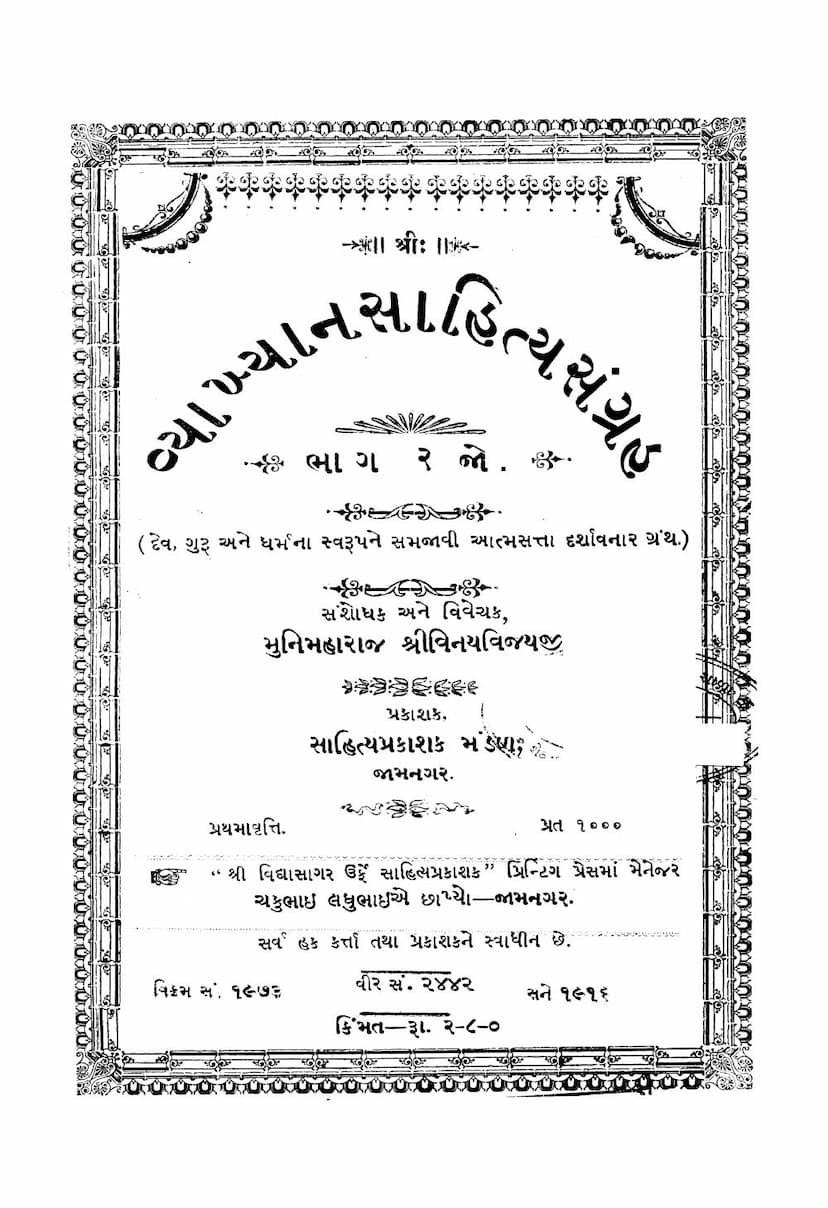Vyakhyan Sahitya Sangraha Part 02
Added to library: September 2, 2025

Summary
Vyakhyan Sahitya Sangraha Part 02 - A Comprehensive Summary
This book, Vyakhyin Sahitya Sangraha Part 02, authored by Vinayvijay and published by Devchand Damji Sheth, is a significant work in Jain literature. It serves as a guide to understanding the essence of Divinity, Gurus, and Dharma, ultimately leading the reader towards self-realization and the path to spiritual liberation.
The book is a collection of discourses and teachings that expound upon various aspects of Jain philosophy and practice. It aims to enlighten both Jain and non-Jain readers by presenting profound spiritual truths in a comprehensible manner.
Key Themes and Content:
The Vyakhyan Sahitya Sangraha, particularly Part 02, delves into a wide array of topics that are crucial for spiritual progress and ethical living. While the provided text focuses on the initial pages and the structure of the book, it highlights several key areas:
- Understanding the Divine, Guru, and Dharma: The book begins with an intention to explain the true nature of God, the spiritual preceptors (Gurus), and the principles of Dharma. This foundational understanding is presented as essential for self-realization (Ātmāsattā).
- The Importance of Pure Literature: The preface emphasizes the need for people to engage with high-quality literature to cultivate noble human qualities and achieve success in life, moving away from trivial or lesser forms of writing.
- The Power of Literature in Education and Persuasion: The author stresses that literature is a powerful tool for teaching and guiding individuals towards the right path. It explains complex principles through detailed explanations, examples, and the illustration of benefits and drawbacks.
- The Syadvada Philosophy: The text touches upon the Jain principle of Syadvada (the doctrine of manifold aspects), suggesting that even followers of other religions, from a certain perspective, can be considered Jain. This inclusivity is rooted in the idea that all religions, to some extent, incorporate elements of the sevenfold classification of viewpoints (Nayas) found in Jainism. The mistake, according to Jainism, is in adhering to one perspective exclusively (ekānta) rather than understanding the relative nature of truth (apekṣā).
- Respect for Other Traditions: The book incorporates writings from non-Jain texts to support Jain principles, citing the principle from the Nandisutra: "Samadr̥ṣṭiparikṛtānyamichchhāttāni samattāṇi" (things accepted by a right perspective, even if seemingly incorrect, become correct). This reflects a broad-minded approach, acknowledging that truth can be found in various traditions when viewed with the right perspective.
- The Author's Humility and Appeal for Correction: The author, Vinayavijay, expresses gratitude to all those who supported the first volume and humbly seeks forgiveness for any errors in the text, requesting readers to point them out for correction in future editions.
- The Structure of the Book: The text indicates that the first part of the Vyakhyan Sahitya Sangraha comprised six chapters (parichchhed), and this second part includes chapters seven, eight, and nine, covering various aspects related to the protection of right faith (Samyaktva) and other practical matters.
- Interrelation of Dharma and Vyavahara (Practice): The book highlights the deep connection between Dharma (religion/ethics) and Vyavahara (worldly conduct). It states that conduct without dharma becomes irreligious, and dharma without proper conduct is incomplete. Both are essential for a balanced spiritual life.
- The Influence of Literature: The introduction underscores the profound impact of literature, comparing a good book to a museum, where one can find various items that uplift, inspire, and guide the reader towards making important decisions and forming convictions.
- Addressing the Need for Gujarati Literature: The author notes the abundance of Jain literature in Sanskrit and Prakrit but points out a deficiency in accessible Gujarati works for a vast Gujarati-speaking population, thus motivating this publication.
- The Book's Content and Scope: The introduction to the second part details the inclusion of chapters on Samyaktva (right faith), its protection, and various related aspects. It also mentions the use of examples from other traditions to support Jain principles, emphasizing the universality of truth.
Dedication and Acknowledgements:
The book is dedicated to Shri Hriman Mahopadhyayaji Gurumaharaj, Shri Viravijay Maharajji. The author, Vinayvijay, expresses deep gratitude to his Guru for inspiring and enabling the publication of this work and other literary ventures.
Key Contributors and Supporters:
The publication of this work was made possible by the generous contributions and support of several individuals and organizations, including:
- Shri Vallabhvijayji Maharaj: A disciple of Shri Viravijay Maharaj, who provided significant assistance in refining the manuscript and research.
- Shri Vidyasagar alias Sahitya Prakashak: Praised for their role in publishing and disseminating Jain literature.
- Shri Chakkubhai Ladhabhai: Manager of Shri Vidyasagar alias Sahitya Prakashak Printing Press.
- Shri Anandji Kagal: A prominent resident of Jamnagar who offered substantial support.
- Shri Makhanji Kanji: Purchased copies of the book and supported the "Sahitya Prakashak Mandal."
- Shri Ujamsi Purushottam: A life member of the "Sahitya Prakashak Mandal."
- Shri Motichand Shamji: Assisted in gaining subscribers.
- Various Sanghas (communities): From Dhoraji, Jetpur, and Padra, who provided enthusiastic support.
Overall Purpose:
The "Vyakhyan Sahitya Sangraha Part 02" aims to provide spiritual guidance and promote ethical living by expounding on Jain principles. It emphasizes the importance of right faith, righteous conduct, and the transformative power of knowledge, all presented in a manner accessible to a wide audience. The book's inclusive approach, drawing from various traditions to support its core message, further enhances its value.